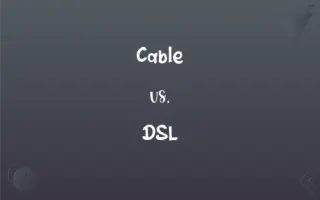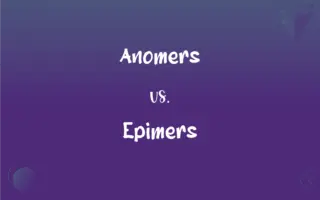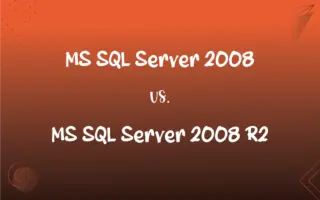Half duplex Transmission Mode vs. Full Duplex Transmission Mode: What's the Difference?
Edited by Aimie Carlson || By Harlon Moss || Published on February 22, 2024
Half duplex transmission mode allows data transmission in both directions, but not simultaneously, while full duplex allows simultaneous two-way data transmission.

Key Differences
Half duplex transmission mode is like a two-way street where traffic can flow in both directions, but not at the same time. It allows data to be sent and received, but these actions cannot occur simultaneously. Full duplex transmission mode, in contrast, is like a dual carriageway, allowing simultaneous two-way traffic; data can be sent and received at the same time.
In half duplex mode, a device must wait for the other to stop transmitting before it can send data. This alternation can lead to delays and inefficiencies in fast-paced environments. Full duplex mode overcomes this limitation by enabling simultaneous sending and receiving of data, increasing efficiency and speed, especially in high-bandwidth applications.
Half duplex mode is simpler and less expensive to implement, often used in walkie-talkies and older networks where cost or technology limits simultaneous transmission. Full duplex mode requires more sophisticated technology, found in modern Ethernet networks and telephone systems, providing smoother and faster communication.
The bandwidth utilization in half duplex is less efficient as it cannot transmit and receive at the same time. Full duplex, with its simultaneous transmission capability, effectively doubles the bandwidth usage, making it suitable for high-speed internet and advanced communication systems.
Half duplex systems are more prone to collisions due to the turn-taking nature of transmission, requiring mechanisms like collision detection. Full duplex systems virtually eliminate the risk of collisions, as separate channels are used for sending and receiving, ensuring a steady and uninterrupted flow of data.
ADVERTISEMENT
Comparison Chart
Transmission Capability
Alternating data transmission, not simultaneous.
Simultaneous two-way data transmission.
Efficiency and Speed
Less efficient, potential delays in communication.
More efficient, suitable for high-speed communication.
Implementation and Cost
Simpler and less expensive to implement.
Requires more complex technology, generally more expensive.
Bandwidth Utilization
Less efficient due to alternate transmission.
Doubles bandwidth usage, more efficient.
Collision Risk
Higher due to alternating nature.
Lower, as separate channels prevent collisions.
ADVERTISEMENT
Half duplex Transmission Mode and Full Duplex Transmission Mode Definitions
Half duplex Transmission Mode
Suited for two-way communication, but not simultaneous.
CB radios typically function in half duplex mode.
Full Duplex Transmission Mode
Allows sending and receiving data at the same time.
High-speed Ethernet networks use full duplex for faster data exchange.
Half duplex Transmission Mode
Alternating sending and receiving of data.
Older network systems often operate in half duplex mode.
Full Duplex Transmission Mode
Simultaneous two-way data transmission.
Modern telephone systems operate in full duplex mode.
Half duplex Transmission Mode
Data transmission in one direction at a time.
Walkie-talkies use half duplex mode for communication.
Full Duplex Transmission Mode
Reduces collision risks in data transmission.
Advanced wireless communication systems employ full duplex to avoid data collisions.
Half duplex Transmission Mode
Involves potential delays due to turn-taking in transmission.
A half duplex intercom requires users to wait their turn to speak.
Full Duplex Transmission Mode
More efficient bandwidth utilization.
Fiber-optic internet connections typically run in full duplex mode.
Half duplex Transmission Mode
Less bandwidth-efficient due to non-simultaneous transmission.
Legacy Ethernet networks using half duplex had limited bandwidth efficiency.
Full Duplex Transmission Mode
Eliminates communication delays seen in half duplex.
Video conferencing systems use full duplex for real-time interaction.
FAQs
What is full duplex transmission mode?
Full duplex allows simultaneous data transmission in both directions.
Where is half duplex mode commonly used?
Half duplex is used in walkie-talkies, CB radios, and older network systems.
Are walkie-talkies an example of half duplex?
Yes, walkie-talkies are a classic example of half duplex communication.
Is half duplex more suitable for simple systems?
Yes, half duplex is more suitable for simpler and cost-effective communication systems.
Is full duplex more complex to implement?
Yes, full duplex is more complex and generally more expensive to implement.
What type of duplex mode is used in high-speed internet?
High-speed internet connections usually use full duplex mode.
Is full duplex mode faster than half duplex?
Yes, full duplex is generally faster due to simultaneous two-way communication.
Are there specific scenarios where half duplex is preferable?
Half duplex may be preferable in cost-sensitive or simple communication scenarios where simultaneous transmission is not necessary.
What is half duplex transmission mode?
Half duplex allows data transmission in either direction, but not simultaneously.
Can half duplex lead to data collisions?
Yes, half duplex can have collisions due to alternating transmission.
Do modern Ethernet networks use full duplex?
Yes, modern Ethernet networks typically operate in full duplex mode for efficiency.
Does half duplex work well in slow-paced environments?
Yes, half duplex can be adequate in environments where high-speed communication is not critical.
How does full duplex prevent data collisions?
Full duplex uses separate channels for sending and receiving, preventing collisions.
Can full duplex double the bandwidth efficiency?
Yes, full duplex effectively doubles bandwidth efficiency by using separate transmission channels.
Does half duplex require turn-taking in communication?
Yes, half duplex requires users to take turns when sending and receiving data.
Can full duplex transmission be used in wireless communication?
Yes, full duplex is increasingly used in advanced wireless communication systems.
How do full duplex systems handle high bandwidth demands?
Full duplex systems handle high bandwidth demands by simultaneously using separate channels for inbound and outbound data.
Are there any disadvantages to full duplex?
The main disadvantage of full duplex is its higher complexity and cost.
Is half duplex outdated technology?
While not necessarily outdated, half duplex is more common in older or simpler communication systems.
Is it possible to switch between half duplex and full duplex?
Some systems allow switching between half duplex and full duplex modes depending on the requirements.
About Author
Written by
Harlon MossHarlon is a seasoned quality moderator and accomplished content writer for Difference Wiki. An alumnus of the prestigious University of California, he earned his degree in Computer Science. Leveraging his academic background, Harlon brings a meticulous and informed perspective to his work, ensuring content accuracy and excellence.
Edited by
Aimie CarlsonAimie Carlson, holding a master's degree in English literature, is a fervent English language enthusiast. She lends her writing talents to Difference Wiki, a prominent website that specializes in comparisons, offering readers insightful analyses that both captivate and inform.




































































